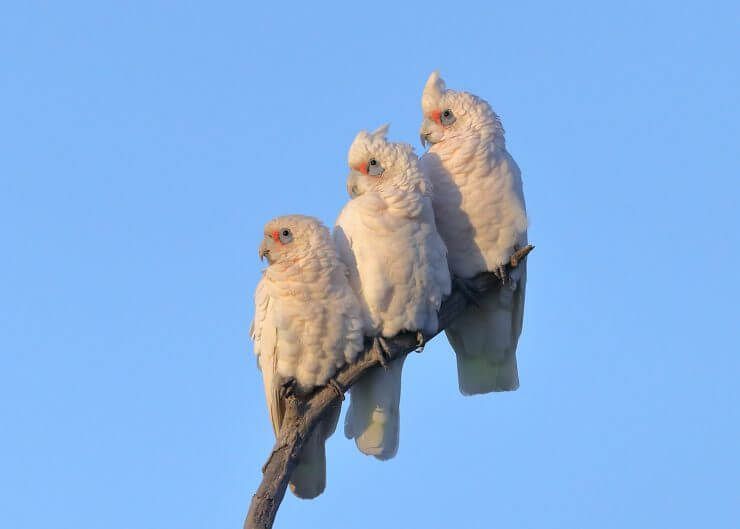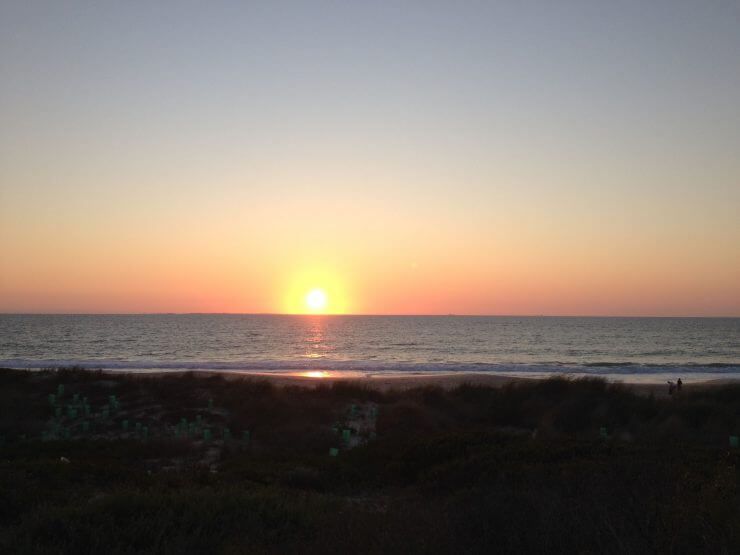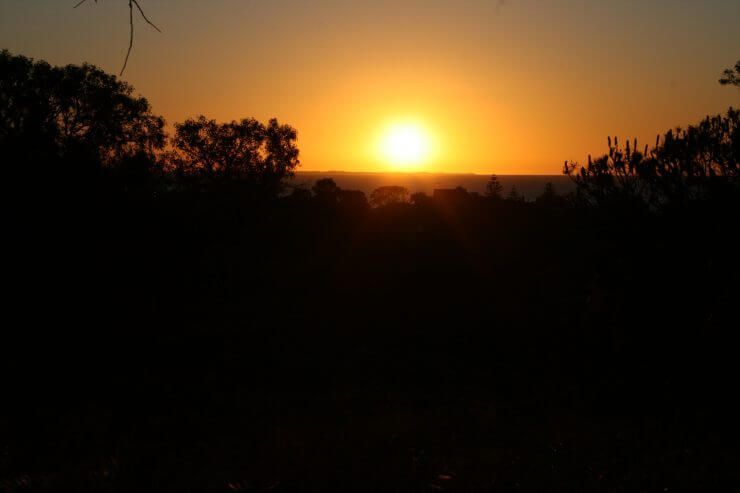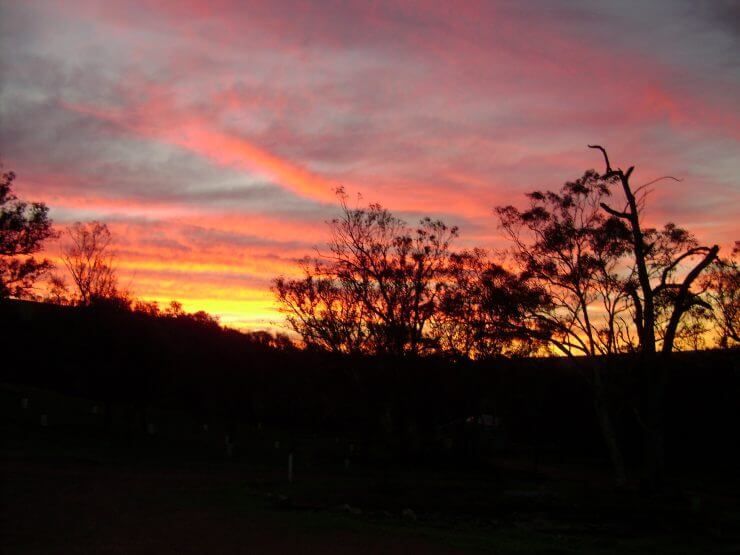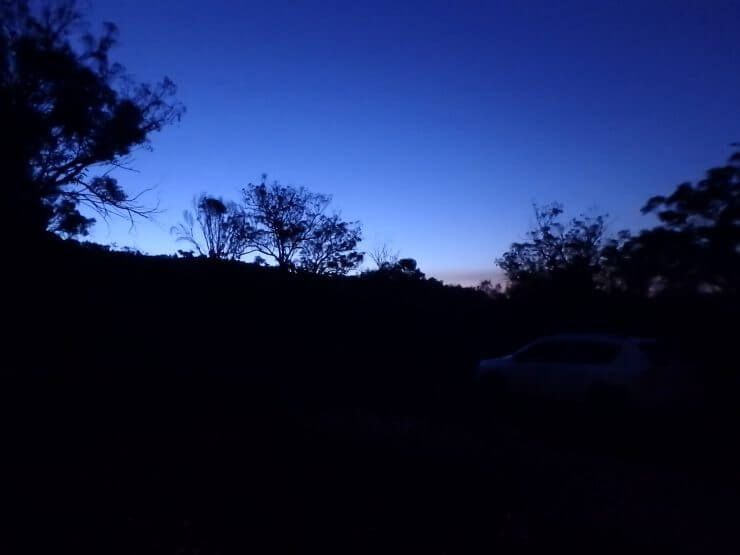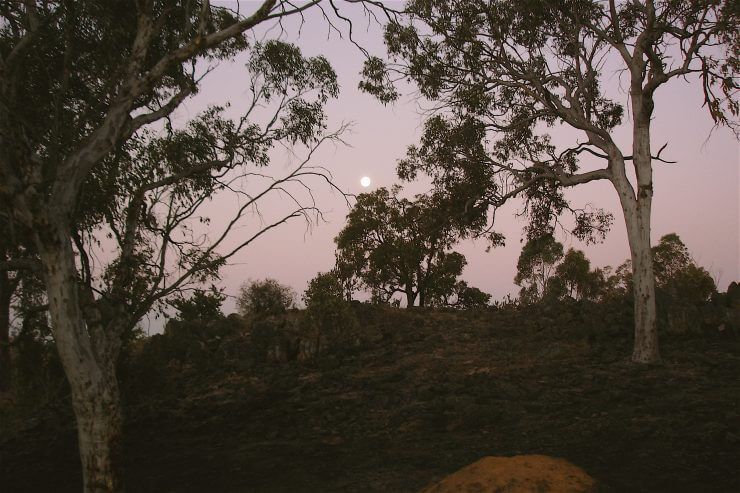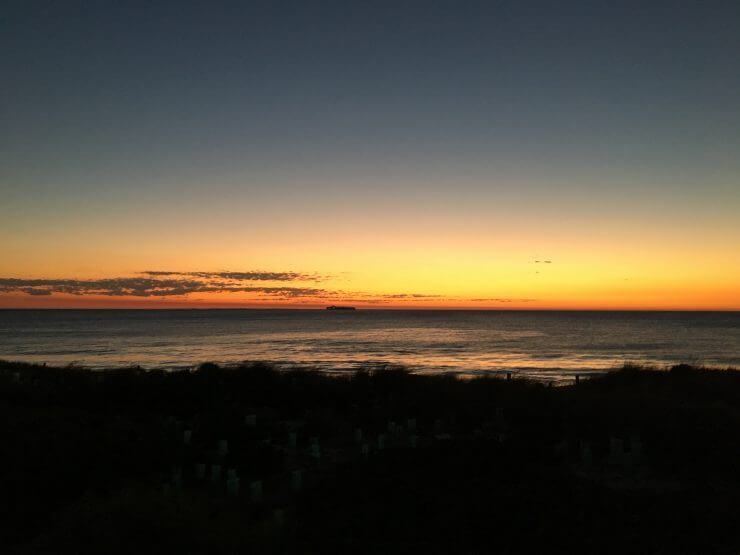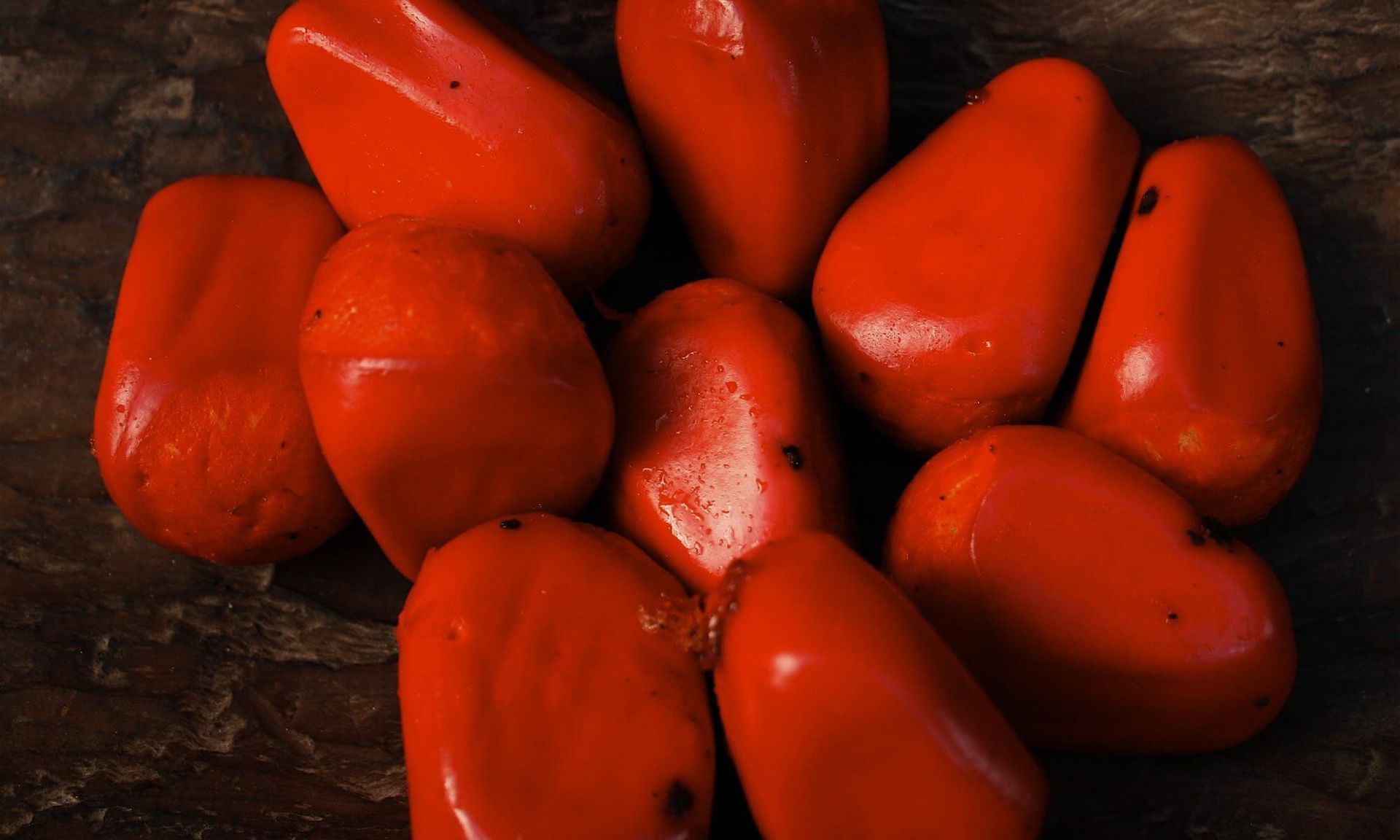Day time reckoning: “Light time” in traditional Noongar culture
Prepared by Ken Macintyre and Barb Dobson
Research anthropologists
“Light time” could be described as a Noongar way of time reckoning using a system of daily categories based on the intensity of light from dawn to dusk.
‘Wanting to know the ideas of the blacks of the origin of mankind, I got him [Mokare] this evening after some difficulty to understand my questions, when he told me that a very long time ago the only person living was an old woman named Annegar [or Arn-ga, a corruption of “Nanga”] who had a beard as large as the garden. She was delivered of a daughter & then died. The daughter called Moerang grew up in the course of time to be a woman, when she had several children (boys and girls), who were the fathers & mothers of all the black people.’ (Barker 1830). 1
Ancestral origin myth – the sun woman
In 1830 Captain Collet Barker collected this origin myth from Mokare, a well-known and respected Minang informant whose family traditionally inhabited the King George Sound/ Albany region. The name “Annegair” may be seen to equate to “Arn-ga” which according to Grey (1840:2) is a linguistic “corruption of “Nanga” meaning ‘the beard.’ It may be viewed as synonymous with “nganga” (the sun) or “ngangan” (mother).’2 Austin (1841 cited in Roth 1902) records ang-a as referring to ‘the sun.” The meanings of these terms arnga, nanga, nganga depending on context may translate as woman, chin, beard, mother, sun – all of which may be seen to characterise Nanga, the bearded sun woman.3
What Mokare appears to be communicating to Barker is the importance of the ancestral female (matrilineal) connection in establishing the origins of the Noongar people in the southern region. Whether this origin myth is widespread or pertains only to the southern people is unclear. Ethel Hassell (1974) points out that the Wheelman (Noongar) who lived to the north of the Minang had a belief that the sun was the abode of their departed ancestors.
This fragment of origin myth collected from Mokare highlights the importance of Nanga the sun woman as the mother of creation and illustrates, using a three-generational model, the importance of matri-focal or female-centred genealogical connections in Minang ancestral descent.4 Nanga gives birth to a daughter called Moerang who becomes the mother of humanity.5 Her children become ‘the immediate progenitors of the black race ’ (Barker 1830) or the local regional Noongar family groups.
In the traditional cosmological and mythological world view the sun woman is seen as an essential and dependable source of light and warmth. Like a Noongar mother she epitomises the maternal principles of creation, fertility, warmth, growth and nourishment. At certain times of day or seasons of the year the light that she brings into the world from her fire-stick diminishes in intensity because of the cold damp wet conditions in the sky. However, the Noongar were always assured that she would ‘return’ in the morning bringing light and warmth back with her. She was the bringer or bearer of light.
Nanga was personifed and given the anthropomorphic characteristics of a woman of senior status who possessed a very long beard. Within Aboriginal society it was not uncommon for senior women to have bearded chins a symbol of their age, status and wisdom. This hirsute feature has become exaggerated in the Nanga mythology to give prominence to her great age, authority and immortal status.
Every day from sunrise to sunset she can be seen walking across the sky carrying her burning fire stick. This is a lighted Banksia cone known as birytch – its meaning deriving from beerat or biryt meaning ‘light’ or ‘daylight’. As a descriptor birytch alludes to the light emanating from the burning Banksia cone carried by Nanga in the sky or light-emanating Banksia cones carried by her earthly descendants who carried a smouldering Banksia cone when moving camp or travelling anywhere. This portable fire-stick was also referred to as “kalla matta” (literally, kalla, fire and matta, leg or ‘fire leg,’ see Moore 1842: 39). This translates into the colourful indigenous metaphor of ‘walking fire.’
Birytch derives its meaning from biryt (light) which was believed to have originated from the kalla matta or ‘walking fire’ of the sun woman.
Biryt may be seen as a composite notion that denotes light in its various manifestations in particular firelight and sunlight or daylight. In recording biryt as ‘daylight,’ Moore (1842:10) notes that the term refers to ‘the day as contra-distinguished from night.’ This is important because it shows that from an indigenous perspective their notion of day or ‘daylight’ derives meaning and significance only when contrasted or “contra-distinguished from night” which is its antithesis.
When Moore (1842) states that Aborigines of southwestern Australia had ‘no idea of the word day, as used by us for a portion of time,’ what he appears to be saying is that their notion of “day” is fundamentally different to our Western concept which defines day as ‘a period of twenty-four hours as a unit of time, reckoned from one midnight to the next, corresponding to a rotation of the earth on its axis” (Dictionary 2009). This is true. They did not apportion the day into hours as we know them.
Moore further comments that their notion of day does not hinder them in their calculation of time and distance which he says they measure in terms of daylights; for example, “biryte gudjal” means “two daylights” or two days. In this context the term biryte may be seen to express both space and time. Bates (in Bridge 1992: 95) also notes the use of “suns” by the traditional inhabitants to measure “days.”
If it is true that the Noongar reckoned time and distance in terms of ‘daylights’ (or days) this makes them relatively unique, for according to Nilsson (1920) in his classic work Primitive Time-Reckoning the use of days or ‘daylights’ for measuring time is relatively rare. He points out with reference to pre-modern cultures that nights or “sleeps” were more commonly used. We note that the early European explorers and settlers often asked their Aboriginal guides how many ‘sleeps’ it would take to reach a particular unknown destination.6
Lyon (1833) implies that time and distance were measured by the number of beedjar (sleeps). However, it is impossible to ascertain whether this is his own Western-centric interpretation of indigenous practice or whether ‘daylights’ (suns) and ‘sleeps’ (nights) were both used to measure time. It is well known that they used ‘moons’ to indicate passage of time. Their calendar was solar-lunar: the sun and the moon being natural chronometers used for reckoning time of day, night and seasonality.
Austin (1841 in Roth 1902) confirms that the Noongar used the sun and the moon to reckon time. He states:
‘Smaller epochs of time were reckoned by the moon (miki), (“big fellow” denoting “full” moon), and the sun (ang-a), according to the elevation of which the day was divided. They had a name for night, as distinguished from day and also terms denoting the points of the compass…’
Daytime temporal categories
Our research suggests that the Noongar traditionally divided their day into at least nine inter-phasing temporal categories corresponding to dawn, daybreak, sunrise, morning, noon, early afternoon, late afternoon, sunset and twilight. These named periods may have been further differentiated into smaller and more subtler divisions of time, depending on the context of their seasonal, cultural and economic activities.7
The passage of the sun across the sky was a time reckoning mechanism used in many ancient cultures. It was accepted that the sun would rise in the east at the beginning of each day and set in the west at the end of the day. This had been happening since time immemorial and formed the basis of daylight or what we refer to in this paper as “light time” reckoning.
The indigenous temporal categories appear (superficially at least) to reflect generally our own Western temporal divisions but without the added mechanical or mathematically devised precision of hours, minutes and seconds. It is possible that the Noongar made even finer temporal distinctions using more subtle and natural criteria such as the position, angle or length of shadow, or the heat of the ground, or observances of animal, bird and insect behaviour at certain times of the day. These perceptive and (yet to a Westerner seemingly inconsequential) temporal indicators would have gone unnoticed by early recorders who were from a foreign culture with a strikingly different temporal perspective.
Indigenous terms and expressions presented in this paper denoting Noongar notions of temporality are sourced from the wordlists of the early colonial recorders, especially Lyon (1833), Grey (1840) and Moore (1842). These terms and idiomatic expressions have been closely examined and where possible translated and re-contextualised within traditional cosmology to provide a glimpse of how Noongar people categorised time using Nanga as their sun clock. Neither of us are trained specialist linguists. Nor do we pretend to be. The Noongar terms and their possible meanings are derived from a careful analysis of early historical and ethnohistorical texts together with information gleaned from contemporary Noongar wordists, such as those of Douglas (1976), Whitehurst (1992), Dench (1994), Mippy (n.d.) and others.
Dawn – Nanga warloo – ‘the sun returns’
Dawn refers to the first appearance of light in the sky before sunrise. There are several terms in the Noongar language denoting this period. These include nanga warloo (or warloo or waullo), literally meaning ‘the sun returns’ or bena (or its numerous variants ben, bina, pene, benang, benar) which translates as dawn, day or morning depending on the context. Grey (1840: 9) records bena as referring to the ‘dawn, milky way.’ This implies early dawn as distinct from late dawn.
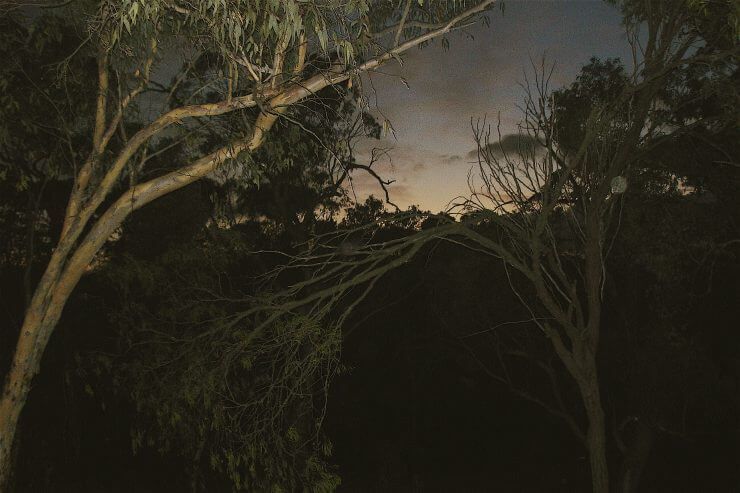
Lyon (1833 in Green 1979: 161, 167) records dawn (or daybreak) as nanga warloo. He translates this as ‘the sun is returning’ or ‘coming back’ (nanga, sun + wuraloo, to come back). This emphasis on the “return” of the sun bringing back warmth and light into the world is highly significant for it signifies the end of the perceived dangers associated with darkness in the form of the djanga (or chinga), ghosts and other spirits that are believed to haunt the night.
Moore (1842) records dawn as waullu (or wallu). He does not include the term nanga as this would have already been contextually understood or assumed by his indigenous informant. Moore defines waullu generally as referring to: ‘Light; dawn; daylight; the morning twilight; the interval between light and darkness’ and ‘the interval between night and day’ (Moore 1842: 72,75).8
Grey (1840: 126) similarly records wauloo as ‘light, dawn, daylight’. He records wol-lo as ‘the day, in contradistinction to the night’ (Grey 1840: 128) and confusingly he records wool-loo-lan at King George Sound as ‘a period of the day, about 9 in the morning.’ In certain contexts, however, waullu, wallu, wauloo or warloo denotes dawn light or morning twilight, recognising the transitional period between darkness and light or between night and day. In the seasonal cycle twilight periods were also recognised at the beginning and tail ends of the Noongar dark and light seasons. These are discussed in a forthcoming paper.
Venus as a temporal indicator of Dawn
The Noongar traditionally used astronomical phenomena such as the sun and the moon and certain selected planets and constellations to reckon their time and seasonality. Bates’ (1914: 81) notes the importance of the planet Venus as an indication of the approach of dawn. One of her informants from the Swan/Guildford area stated “tian” bena kwejat kulert which she translates as ‘“Venus” tells us daylight is coming, or literally ‘“Venus” daylight directly coming.’ Another informant from the Beverley/ York area stated ben yual guling which Bates (1914: 80) translates as ‘Daylight (or morning) is coming.’ Venus is well-recognised in many cultures as the ‘Morning Star’ which heralds the dawn. In Noongar language it may be translated as the ‘Daylight’ star – or ‘Dawn’ star. It is a highly dependable marker indicating the return of daylight. The movements of the three brightest objects in the sky (the sun, the moon and Venus) together with other formations were used for time reckoning on both a daily and seasonal basis. The bold appearance of Venus in the night sky advertising the approach of dawn must have been a very reassuring sign to the Noongar that Nanga would soon reappear bringing light, warmth and life back into the world.
Moore (1842: 37) records Venus as Julagoling (synonymous with Bates “yual guling” above) and states that: “’She is described as a very pretty young woman, powerful in witchcraft. A singular, if fortuitous, coincidence with her classical character.’ In traditional Noongar cosmology all planets were viewed as sorcerers and having magical powers (Hassell 1974). Grey (1840:56) similarly records Julagoling as ‘a name for the planet Venus’ and Brady (1845) records it as ‘the evening star.’ Grey (1840:30) records djukolung as meaning “a big sister” (see “Djuko” sister). We are curious about this for in some Aboriginal groups in Victoria the indigenous name for Venus means ‘sister of the sun.’ Could it be possible that the Noongar perceived Venus and the sun in a sisterly kin relationship?
Venus is viewed as the elder sister of the sun in some cultures according to Nilsson (1920). But whether this was the case in Noongar culture we may never know. Both Venus and the Sun are bright beacons of light and are chronologically connected, one always appearing in the sky before the other. In Noongar astro-mythology the stars and planets are commonly perceived as having familial and societal structures similar to those found among the earthbound Noongar (Hassell 1936, 1975).
Daybreak: Djidar–birds (break of day birds), dawn song ‘Cockatoo crow’ as an indication of daybreak
The terms je-dar, ‘morning dawn’ (Grey 1840: 53), jeeda, ‘daylight’ (Grey 1840:53) and djidar, ‘dawn of morning, daylight’ (Moore 1842:21) may be viewed as variant spellings or renditions of the same term pronounced jeeda which denotes ‘bird.’ In this context the term probably alludes to the dawn song of the break-of-day birds. The subtleties of birdsong at this time of day were well known to Noongar people and Mokare exemplifies this when he informs Barker (1830) that “daylight’ was heralded by the cries of the cockatoos. Barker must have found this unique cultural interpretation amusing for he writes in his diary that daybreak was proclaimed by the “Cockatoo crow” rather than by the “cock crow” (as it is known by Westerners). We would suggest that Mokare is referring to the screeching sounds of the white cockatoos (manyt, also spelt manich,munite, monet, munitch, manatch) heralding the daybreak.
The white cockatoo (Western Corella, Cacatua pastinator) is traditionally of great cultural significance to Noongar people symbolising one of their main societal divisions known as Manitchmat (white cockatoo, manitch + mat, family or ancestral stock). This division corresponds to the “light” half of society (or moiety) and signifies the maternal life-giving attributes of warmth, nourishment, light and life, which are the same qualities attributed to Nanga the sun woman. Not only is the white cockatoo of totemic significance, daylight is also a totem.
Ethel Hassell (1974:232) records kittiupcowra as ‘just before daylight – when the bird calls commence.’ She lists cowra as ‘green parakeet.’ If we take kittiup to be a variant of kittiuk meaning ‘dark’ or ‘night’ then kittiup-cowra would refer to the screeching sounds of parrots heralding the break of day.9 Moore (1842) records kowar as the screaming parrot (Trichoglossus) but this genus is not native to southwestern Australia. Serventy and Whittell (1976: 267) attribute the name kowar (cower or cowara) to the purple-crowned lorikeet (Glossopsitta porphyrocephala) which is well known for its loud screeching sounds. Parrots and cockatoos, although distinguished in indigenous taxonomy, would have been perceived as belonging to the same family or ancestral stock as they share a number of physical, behavioural, phenological and cultural habits and characteristics 10 Their break-of-day cries would have served as a natural alarm clock signalling the return of daylight.
Sunrise: Nangar mooreejoon, Nanga batta-nynowl
Grey (1840: 47) records gungal as meaning ‘the east.’ Moore (1842: 40) elaborates on this and describes kangal as meaning ‘The east; or, more properly, the spot of sun-rising, as it varies throughout the year.’ This term designates the spatial location of where Nanga rises every morning.11 Interestingly, the “sun cave,” also called the “moon cave” was located by early 19th century explorers near York, Western Australia (first by Moore and Dale in 1830 when exploring the Avon Valley). This cave contains ancient markings and representations of the moon and/or sun beings who in Noongar mythology are depicted as husband and wife.
Nangar mooreejoon
Lyon (1833 in Green 1979: 161) records the early sunrise period as nangar mooreejoon which he translates as ‘to give light; to see.’ He explains that ‘this expression seems to import the sun dispelling the darkness’ (p. 161). We would suggest that mooreejoon derives from murrijo which Moore 1842: 58) records as ‘to move, to go, to walk’ (or moorijo, ‘to go’ Grey 1840: 87). Thus nangar mooreejoon may be viewed as an ambulatory metaphor which refers to the sun woman beginning her daily “walk” across the sky carrying her kalla matta (‘walking fire’).
Lyon’s (1833) notion of “the sun dispelling the darkness’ succinctly captures the intrinsic fear of darkness held by traditional Noongars. It was their belief that sunlight and firelight dispelled the dangerous and much feared spirits and ghosts that inhabited dark places and the darkness of night. It was for this reason that bright firelight was often portrayed as synonymous with sunlight; however, nothing removed the fear of the supernatural more effectively than the rising of the sun.
Nanga batta-nynowl
Lyon (1833 in Green 1979: 161) also records the expressive phrase nanga batta-nynowl which he translates as ‘the sun is risen – literally – enthroned.’ This evokes a vivid illusion of the sun woman sitting stationary on the horizon spreading out her radiant beams of light (nanga batta or sun rays). Nynow means ‘to sit or to remain for a time in any place.’ This denotes an image of the sun woman sitting down, possibly while she kindles or ignites her fire stick ready for the long journey.
Morning: Mirgaduk
Lyon (in Green 1979: 161) records mirgaduk as ‘morning’ but does not specify which part of the morning between sunrise and noon that this refers to. Moore (1842: 105) records morh-ragadak as ‘morrow, tomorrow. ’ The old English term ‘morrow’ derives form morgen (of Germanic origin) meaning ‘morning’ or ‘morn.’ Morhragadak (a variant rendition of mirgaduk) possibly derives its meaning from the Noongar term moorgyle which Grey (1840: 87) records as meaning ‘plenty – in this context denoting plenty of light and heat as the morning progresses into malyarak the hottest part of the day.
Midday, Noon: Mal-yarak
Mal-yarak refers to noon or the middle of the day when the sun is directly overhead. This is generally the brightest time of day when the sun is at its zenith. Mal-yarak may derive from mal-yar which Moore (1842:67) records as ‘the ignited portion of a piece of burning wood’ + ak, denotes of, or pertaining to. This could be a mythological metaphor suggestive of the sun woman re-igniting her fire stick or kindling a fire at her ‘sit-down’ place high in the sky at this time. Moore records yirak as meaning ‘high up’ (yirak is probably the same as yarak) most likely referring to the ‘high up’ elevated position of Nanga in the sky at mid-day when she is mid-point (meridian) between the horizons. Her perceived activities involving the bright light (igniting or rekindling her kalla matta, ‘walking fire’) possibly signal the time for Noongar women (and men) to stop what they are doing and, using the ignited portion of their fire-sticks, to light a campfire for the preparation of some food or warmth and to have a rest in the shade or afternoon “siesta” (bidjar).
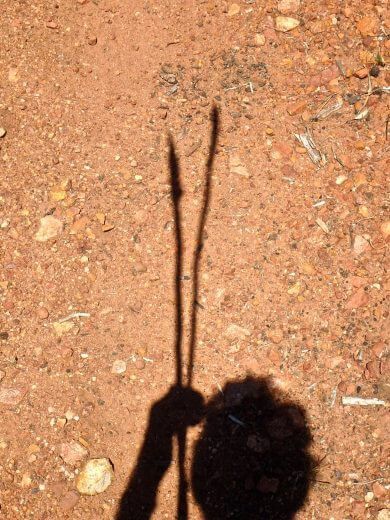
Lyon (1833 in Green 1979: 161) records Nanga banya as ‘a hot, or sweating sun.’ Ban-ya means ‘to sweat’ or ‘to perspire’ or ‘become wet with perspiration’. It is unclear whether this expression denotes a particular time of day such as midday or soon afterwards when the sun is at its hottest and causing people to perspire, or whether it is a reference to the sun woman herself sweating and causing atmospheric humidity. One can only speculate.
In cultural mythology Ngang-ga or Nanga is always watching the Noongar ‘from her high road’ as she travels from the east to west across the sky (Bates in Bridge 1992:147). One Noongar Elder from the Pinjarra region (personal communication with us in 1996) described the sun’s movement across the sky colloquially as “nganga bidi” meaning the “run” of the sun (bidi, in Noongar means pathway, track or ‘run’).
The ‘sit-down’ or resting periods during Nanga’s daily trek across the sky serve to demarcate temporal divisions and also influence human activities on earth at this time. This mythological illusion of the sun woman does not mean that the sun stops its motion at any time but rather that the “sitting” notion is used metaphorically to suggest that at certain times of day there is a perceived degree of constancy in the sun’s energy output.
Early afternoon: Biddurong – Siesta or Resting Time
Biddurong refers to the ‘early afternoon’ or according to Moore (1842:8) ‘about two o’clock in the day.’ This was the Noongar siesta time when the sun was still high in the sky (beerdyat, high, Lyon 1833). In the hot dry season it probably corresponded to the hottest part of the day and signified a time for resting in the shade and avoiding the intensity of the strong sunlight. This time of rest and recuperation was also practiced by traditional (and contemporary) people living in the Western Desert (Macintyre field notes 1973). These people had usually been up since dawn carrying out activities before it got too hot. Biddurong probably derives its meaning from bidjar meaning ‘sleep or state of repose’ (see glossary at end under bidjar or beedjar). Lyon 1833 (in Green 1979: 161) points out that the term bidooroong was not only used to refer to ‘afternoon’ but also applied to ‘night.’ He comments that night was ‘the proper time” for beedjar.
Late afternoon: Garbala
Grey (1841: 41) records gar-ba-la as ‘between three and four o’clock in the afternoon.’ He is quite specific about the timing of this period of day, whereas Moore (1842: 28) refers to garbala as ‘’the afternoon; the evening; towards sunset’ which suggests a more generalised notion of late afternoon. At this time when the day begins to cool down and light begins to fade, people start collecting firewood and preparing their campfires ready for cooking the evening meal. Garbala probably denotes ‘the hungry time’ for Lyon 1833 records caburla (in Green 1979:155) or karbarla (in Bindon and Chadwick 1992: 76) as referring to ‘the belly’ and in this context it may have denoted hunger.
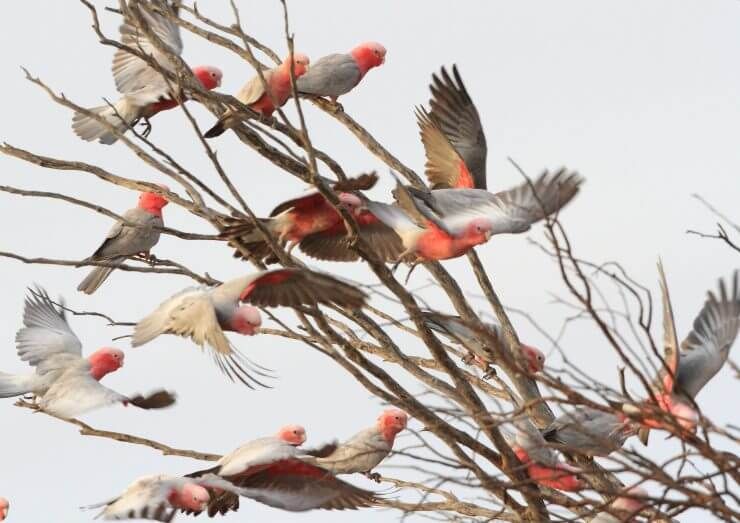
Sunset: Garreembee
Sunset is the completion of the sun’s daily cycle. Lyon (1833 in Green 1979: 161) records the term for ‘sun set’ as garreembee. Grey (1840:47) records gur-rim-be as ‘about sunset’ and Moore (1842:29) lists garrimbi as ‘about sunset.’
Nanga ngnardog
Lyon (1833) records nanga ngnardog as ‘the sun is set.’Ngnardung or ngardang means ‘to creep’ and ngardul or ngardal means ‘low, lying low, low in position or below’ (see glossary). This idiomatic expression captures the illusion of the sun creeping downwards as if fearful of the darkness inundating the landscape. Ngardog is synonymous with Ngardak meaning ‘downwards’ and literally refers to Nanga sinking down below the western horizon as she crawls into her maia (or mia, mya) for a good night’s sleep.
Bates (1992: 147) refers to the sun woman traveling all day until she reaches her ‘night home’ where she goes to sleep ‘inside her maia.’ (Bates in Bridge 1992:147). Then at daybreak she rises again and repeats her daily trek across the sky from east to west. The time when the sun stays below the horizon is the time for sleeping (beedjar).
Another term for ‘sunset’ is dtabbat meaning literally ‘to set as the sun; to fall down.'(Moore 1842: 23). It evokes the image of nanga all worn out after her long day’s journey ‘falling’ or tumbling down into her mia or cave ready for a good night’s sleep.
Another expression for ‘sundown’ is ngungarn yuck (Buller-Murphy n.d). This may be a reference to the sun woman’s multiple roles including wife (yuck) of the moon man (meeka, meki). (Ngungarn means mother or woman + yuck (also yuk, yug, yorg) means wife.
The multiplicity of indigenous descriptors denoting time of sunrise and sunset suggests that these were important temporal structural reference points. Gurrimbee ‘about sunset’ may be viewed as simultaneously part-day and part-night or what we commonly refer to as ‘twilight.’ It represents an admixture of darkness and light and is a time of transition. As the darkness captures the light, the shadows make it difficult to recognise people and at this time evil spirits and ghosts are believed to awaken. The Noongar stay close to their campfires and if they need to travel or hunt at night, they always carry a fire stick to provide light, warmth and protection from any dangerous and marauding spirits.
Twilight: Ngal-lan-bur-rang; Ngallanang
Twilight is the period of early evening between daylight and darkness when the sun is below the horizon. There is a soft glowing light from the sky caused by the refraction and scattering of the sun’s rays from the atmosphere. As the light begins to fade into darkness people start to prepare for the night.
This twilight or early evening period is known as ngal-lan-bur-rang (Grey 1840:104) or ngallanang (Moore 1842:64). Ngallanang probably derives from ngala which denotes an inclusive duality or relationship between two people or entities. It may denote ‘we two, the dual between parents and children’ (Grey 1840: 104) or ngalli ‘we two (the dual between brothers and sisters, or two friends’ (Grey 1840: 104) or it may refer to the inclusive duality of ‘husband and wife’ (Bates 1914: 69). In this context it may be an indigenous metaphorical or mythological allusion to the coming together of night and day for the moon and sun are depicted in Noongar mythology as husband and wife. This blending together of darkness and light can be likened to a veil of darkness obscuring the light or it may be compared to looking through a mist whereby people’s facial features and characteristics become unrecognisable. Individuals become dark silhouettes in the shadows, making it difficult to distinguish between friend, foe or evil spirit. This is a dangerous time when people stoke their fires (kalla) and stay near the warmth and light of their hearths while awaiting the inevitable onset of darkness. Bates (1914: 79) records this time of day as marerdak yenin meaning ‘the coming of darkness’ or literally in the Pinjarra dialect “dark coming.”
Grey (1840) records ngal-lan-bur-rang as twilight or early evening. In his wordlist he records burrang as meaning ‘to bring’ or ‘to abduct’ (Grey 1840: 21). Similarly, Moore (1842) records barrang ‘as ‘to carry off.’ Hence ngallanburrang may be seen to evoke an image of the light being captured, taken away or carried off by the dark. Twilight was perceived to be the time when the much-feared spirits of the night awoke and started to haunt the darkness. Possibly this cultural idiom is an allusion to the moon man (meeka) ‘abducting’ or carrying off the sun woman (nanga).
Moore (1842) records ‘kado barrang’ as meaning ‘to abduct.’ Twilight is the time when the moon takes over from the sun. It is possible the Noongar distinguished between the early twilight when darkness and light first come together known as ngallanang (part-day and part-night) and ngal-lan-bur-rang the latter part of the twilight period or early evening.
Night – kittyuk,kattik, kartiac, kat-teek
The Noongar distinguished between the day (beerat) and night (kittyuk). This oppositional symbolism or dualism of dark and light permeated many key aspects of their society and culture, including their “light” and “dark” moieties, “dark” and “light” totems (animals, plants, birds etc) and their “dark” and “light” seasons.” The symbolic binary classifications were modelled on the naturally occurring day-night cycle. Even the annual Noongar seasonal cycle may even be seen as representing a macrocosm of the day-night cycle. They recognised two primordial over-arching seasons – the dark and the light – and a host of other seasons and sub-seasons interspersed within and between these including ‘little seasons’ or ‘part seasons’ all of which were finely attuned to the subtleties of climatic variation, photoperiodicity and animal, plant and bird phenological breeding cycles. However, seasonality is the focus of another paper, not this one, so let’s get back to indigenous perceptions of “dark time” or night time. As we have already noted indigenous perceptions of day or ‘daylight’ derive meaning and significance only when contrasted or “contra-distinguished from night” (Moore 1842) which is its antithesis.
Some of the terms recorded for ‘night’ are translated in early wordlists as meaning ‘dark’ or darkness. One term commonly listed for night is kat-teek (Grey 1840: 63) or kattyuk (Moore 1842). Its meaning probably derives from kittiuk which Moore (1842) defines as ‘a portion of the whole…. Generally half.’ This describes a quantitative measurement for darkness or night, that being a portion (generally half) of the whole (day-night) cycle.
Another term for ‘night’ is myarduk. The stem term myar (mya or maia) means shelter, house or home (also cave, nest). Myarduk is the time when nanga the sun woman crawls into her myar to sleep. It signifies darkness, night and time for sleeping. The term bidooroong is recorded by Lyon (1833 in Green 1979: 161) as ‘afternoon. Also, night.’ This suggests that the sleep pattern of Noongar hunter-gatherers was biphasic (two phase) consisting of a long nocturnal sleep period and a shorter early afternoon sleep or resting time. it is unclear whether midnight was important but A.Y. Hassell records their expression for “midnight” as coutiock wolock (literally, coutiock, night + wolock, ‘midday).
SUMMARY
Nanga the Noongar sun clock travels across the sky every day from east to west, kindling her biryte (Banksia fire cone) every morning and carrying it with her throughout her long journey. In some seasons she has trouble igniting it or keeping it alight because of the damp, wet conditions in the sky. The Noongar traditionally alluded to, and were guided by, the movements and activities of Nanga as she blazed her way across the sky before sinking down below the western horizon.
Our analysis of wordlists compiled by the early colonial recorders would suggest that the Noongar traditionally distinguished at least nine inter-phasing temporal “day time” categories and possibly additional subcategories based on subtle changes in natural phenomena, such as the changing position of Nanga in the sky and the associated incremental changes in light and heat intensity. All named periods of ‘light time’ may have been differentiated into smaller and more subtler divisions of time, depending on the context of seasonal, cultural and economic activities. By classifying “daylight” into temporal categories the Noongar were able to plan and regulate their activities. According to Daisy Bates (1992: 95) the Noongar used number of “suns” to measure “days.”
The horizon (where the sky merges with the earth) formed the all-important visual boundary between night and day. Nanga’s re-appearance at dawn was a welcome event signalling the return of light, warmth and life into the world. The Noongar language with its culturally descriptive expressions denoting time of day includes idiomatic expressions that are rich and colourful, especially those referring to sunrise, sunset and the morning and evening twilight. These were culturally significant times. For example, dawn or waullo – the ‘coming back’ or return of sunlight – was considered a critical time in traditional hunter-gatherer society because it removed the constant anxiety and fear culturally associated with darkness and dangerous spirits. When the light of dawn “returned,” the marauding spirits of the night suddenly vanished into unknown hidden places.
The origin myth which Mokare related to Captain Barker (1830) highlights the importance of Nanga (or Arnga, Arrnegair) – the bearded woman, sun woman and mother – as the mother of all creation. She is perceived as the original source of light and life. She is the personification of motherhood and her quintessential qualities symbolise maternity, light, warmth and nurturance. It is believed that through the ancestral mythical figures of Arnga (or Annegair as Barker’s spells it, a corruption of “Nanga“) and her daughter Moenang and her children, the Noongar people were created.
The focus of this paper has been on “light time” reckoning in traditional Noongar society. We would conclude that their “light time” reckoning device is no less valid than ours, just different. It derives from long-term empirical observations and culturally inherited knowledge and understanding of recurring solar, lunar, astronomical and earthly phenomena which were used to define the passage of time on both a long term (annual, seasonal) and short term (day-night) basis. This accrued knowledge was passed down from generation to generation over many millennia. It was the practical and utilitarian aspects of light in all of its manifestations (sunlight, firelight etc) that structured and governed their economic, social, ceremonial and cultural activities. The multifaceted and practical significance of light explains the importance of the dichotomous dark-light symbolism which lies at the core of traditional Noongar culture and society: it is embedded in their traditional moiety structure (“dark” and “light” moieties) and in their temporal and seasonal determinations (“dark” season and “light” season).
The indigenous daytime or ‘light time’ reckoning nomenclature may be seen as constituting a series of descriptive expressions or metaphors, the meanings of which vary depending on seasonality and fluctuations in light intensity and temperature. We have had great difficulty disentangling many of the Western-centric assumptions underlying our interpretations of Noongar time reckoning owing to the fact that as Western- trained researchers we are ourselves a product of the Western system of temporal hegemony. To think like a traditional Noongar, one would have to imagine living in a hunter-gatherer society and being wholly dependent on the naturally recurring cycles to ascertain time and seasonality.
Finally, it is hoped that this paper provides a contribution to the anthropology of light (luminosity) with special reference to daytime reckoning as practised by a hunter-gatherer population in southwestern Australia who, contrary to popular views, possessed a perception of time and a system for its measurement, enabling them to predict, plan and carry out their daily and seasonal activities. Like other traditional hunter-gatherer peoples throughout the world, they evolved their own culturally logical and appropriate, independent system of temporal and seasonal differentiation based on the natural phenomena around them.
ACKNOWLEDGEMENTS
This paper is based on extensive archival research and information gained from fieldwork involving Noongar Elders from the Perth, Pinjarra, Busselton and Albany regions. We would like to thank all Nyungar Elders (past and present) who have contributed to this work.
ANNOTATIONS
1.Barker’s Annegar or Annegair may be seen to equate to Grey’s Arnga “a corruption of Nanga, meaning ‘the beard,’ also a reference to the bearded sun woman. Grey (1840: 1050 translates nganga as ‘the sun’ and ngangan as ‘a mother.’ The names of the southern Noongar pivotal ancestors Annegar (great grandmother) and her daughter Moerang (said to be the grandmother to humanity) have been carefully transcribed by ourselves from Barker’s original journal based on a microfilm copy in the Battye Library. We are aware that Green and Mulvaney (1992) have already transcribed these names to Arregair and Moenang; however, our analysis of Barker’s hard-to-decipher handwriting suggests that the names are perhaps better rendered as Annegar (or Annegair) and Moerang. Barker’s handwritten ’n’s and ‘r’s are very difficult to interpret. For example, Green and Mulvaney (1992) interpreted Barker’s recorded name for the winter season as Moken; however we would interpret his writing as Moker.
2. It is easy to understand how Aboriginal terms may become corrupted when transcribed from an unfamiliar oral language into a written form. Different spellings and renderings of the same core term may reflect dialectical or regional linguistic variation or different recorder’s preferred orthography.
3. The gendered identities of the sun and moon are culturally specific and vary from group to group and from culture to culture. In some North American Indian and African groups the sun is viewed as male and the moon as female whereas the opposite is the case among the Noongar (and most if not all Australian Aboriginal groups). In Noongar mythology the moon man is depicted as the husband of the sun woman.
4. In southern Noongar mythology the sun woman, through her daughter Moerang, is seen as the ultimate progenitor of the indigenous people of King George Sound. By contrast some Aboriginal groups in Queensland and New South Wales view the moon as’ their original progenitor’ (see Montagu 1937: 138). This may possibly emphasise a system of patrilineal descent from a male progenitor as opposed to the sun mother and her daughter symbolising a system of matrilineal descent (see Bates re matrilineal descent in the southern region of Western Australia in Bridge 1992).
5. It is our view that the name Moerang equates to “Moyran” which means grandmother and a woman of high political standing within the community who has privileges of seniority and political influence conferred upon her at a special ceremonial meeting known as monyo (See details in Moore 1842: 55).
6. Up until the 1980’s some anthropologists were still using this method of calculating the number of “camps or “sleeps” when trying to estimate the spatiotemporal distance of one geographic place to another, especially when trying to locate named Aboriginal heritage sites for recording purposes. However, this was not deemed a reliable measurement for reckoning distance or time. Cross-cultural differences in ways of traveling the country, for example, whether by foot or car, number of stops along the way, directness or indirectness of the route taken, the number of years that had lapsed since the informant had last visited the site, potential confusion as to which site the anthropologist was actually searching for, the reliability of individual memory and recall, would have contributed to make this method of time-space calculation unreliable.
7. Hunter-gatherer Noongars had an astute awareness of the time of day and night using subtle natural indicators and over many thousands of years they had evolved their own system of temporal and seasonal differentiation based on observable natural phenomena.
8. Waullu – This term, like numerous other culturally significant terms in the Noongar language, has a composite of meanings which are usually associated in symbolic or practical terms. The context may not have been referred to but was understood by the native speaker. The intended meaning depended on context.
9. Kittiupcowra is a compound term. It may translate as kittiuk or kittiup, night + cowra, parrot whose screeching calls in the pre-dawn hours, like the cockatoo cries, provided a wake-up signal during the warm “light” season.
10. Kittiupcowra – It should be noted that although the Noongar would have been entirely familiar with the obvious physical and behavioural differences between parrots and cockatoos on the basis of differing colours and physical characteristics, in certain contexts they may have been collectively considered as an all-inclusive family or order of birds based on many similar physical features, habits and cultural significance. They provided a source of dadj (food) and feathers for ceremonial adornment purposes. The parrot breeding season of mondyianong (as it is known at King George Sound, commencing in mid-late October) collectively includes a range of edible birds and their nestlings.
11. Kangal refers to the spot where the sun rises in the east at any particular time of the year. Since it designates a co-variant reference point it should not be mistaken for the fixed cardinal point known as “east.” Whether there are specific identifiable on-the-ground features that correspond to kangal in traditional Noongar mythology we are unsure but we would conjecture that the moon cave (also known as ‘the sun cave’) near York may be such a reference point in the localised Noongar sun-moon mythology.
GLOSSARY OF TERMS
arn-ga –the beard (a corruption of “Nanga”) (Grey 1840: 1)
annegair – treated as a variant of arn-ga (or “Nanga”)
bee-rai, or bee-rait – daylight, the day (Grey 1840: 9)
beedjar – sleep. This is the term by which they reckon both time and distance. Not so many days, but so many beedjars; that is so many sleeps, or nights; nights being the proper time for sleep.’ (Lyon 1833 in Green 1979: 166)
beerat – day (Lyon 1833 in Green 1979)
beeritch – day (E. Hassell n.d.)
beerijil – noon (E. Hassell n.d.)
be-rytche, or be-ytche – small cone of the Banksia, somewhat resembling Met-jo: it burns slowly, like a pastil. (Grey 1840: 10) [it is easy to see how Hassell’s beeritch (day) derives its meaning from berytche, the burning banksia cone of the mythological sun woman).
biddurong – about two o’clock in the day (Moore 1842: 8)
bid-jar – sleep, a state of repose (Grey 1840: 10)
bidooroong – afternoon. Also, night. (Lyon 1833 in Green 1979: 161)
bid-doo-rong – the forenoon about ten o’clock (Grey 1841: 10) (Moore corrects this in his own work to early afternoon, see discussion in our text.
bidjar – sleep. (Moore 1842: 8)
bidjar ngwundow – to sleep; to go to sleep; to lie down to sleep (Moore 1842: 8)
biddurong – about two o’clock in the day (Moore 1842: 8)
bidooroong – afternoon. Also night. (Lyon 1833 in Green 1979: 161)
birytch – ‘the cone of the Biara or narrow-leaved Banksia. It burns like touchwood. One is generally carried ignited by the women in summer, as pieces of burning bark are in winter, to make a fire.’ (Moore 1842: 10).
bi-ytch – Banksia seed cone (Simmons 1841: vii)
biryt – daylight. The day as contradistinguished from night. (Moore 1842: 10).
beerat – day (Lyon 1833 in Green 1979: 161)
djidar – dawn of morning; daylight (Moore 1842: 21)
garreembee – sun set (Lyon 1833 in Green 1979: 161)
jee-da – daylight (“Bee-rait.”) (Grey 1840:53)
jedar – morning dawn, (see “beryte”) (Grey 1840:53)
mal-ya – the ignited part of a piece of wood (Grey 1840: 78)
malyar – the ignited portion of a piece of burning wood (Moore 1842: 48)
mal-ya-ruk –mid-day (Grey 1840:78)
mal-yarak – mid-day, noon (Moore 1842: 48, 106)
malyarak – meridian [noon] (Lyon 1833 in Green 1979: 161)
malyarak – light (Curr 1886)
mo-nak. – clear, sunshiny, fine weather, warm weather. (Grey 1840: 85)
moonak – the place where the Deity is more immediately supposed to display his presence; Heaven (Lyon 1833 in Green 1979)
moonak – heat (Curr 1886 Toodyay)
moonak – white cockatoo (Curr 1886 York)
monark – heat (Curr, Lower Blackwood)
nanga banya – ‘a hot, or sweating sun’ (Lyon 1833 in Green 1979: 161)
nanga batta-nynowl – ‘the sun is risen – literally – enthroned.’ (Lyon 1833 in Green 1979: 161) (nanga, sun + batta, beams + nynow = ‘to sit down, properly, with the hands folded’ (Lyon p. 166;) nginnow – ‘to sit, to remain for a time in any place’. (Grey 1840: 106); n- yinnow –‘to sit, to remain in a place any time’ (Moore 1842: 63)]
nanga mooreejoon –‘to give light; to see. The expression seems to import the sun dispelling the darkness.’ (Lyon 1833 in Green 1979: 161)
nanga ngnardog – the sun is set (Lyon 1833in Green 1979: 161)
nanga warloo – ‘the sun is returning’ (wuraloo, ‘come back’) (Lyon 1833 in Green 1979: 161, 167). (a mythological reference to the return of Nanga, the Sun Woman)
*ngala = dual ‘we two, parent and child, uncle and nephew’ Moore (1842). [NB this implies inclusive pronouns or inclusive familial relationships]
ngal-lan-bur-rang ‘twilight’ (Grey 1840:104) ngallanang as ‘evening’ or ‘twilight’ (Moore 1842:64) mirgaduk – morning (Lyon 1833 in Green 1979: 161)
ngangka = sun
ngangka = mother
nyanuck – beard (King 1827)
wau-loo –‘light, dawn, daylight., also a clear open space where the sky is visible.’ (Grey1840: 126)
waullu – ‘Light; dawn; daylight; the morning twilight; the interval between light and darkness’; a clear open space without trees; an interval or open space between two objects; the division of the hair, when parted on the top of the head; partial baldness..’ (Moore 1842: 75)
wallu – ‘An interval or open space between two points or objects; the division of the hair when parted on top of the head; partial baldness’ morning twilight, the interval between night and day.’ (Moore 1842: 72)

